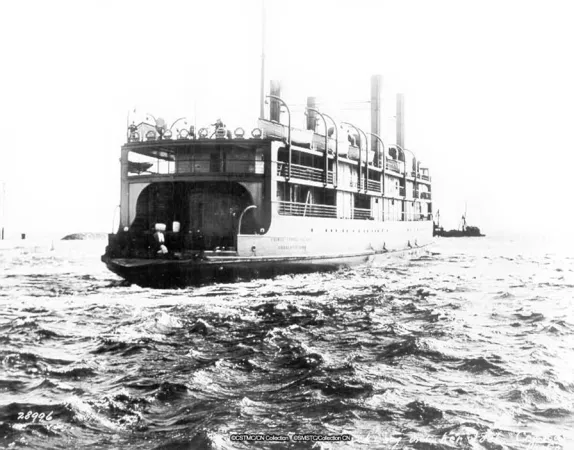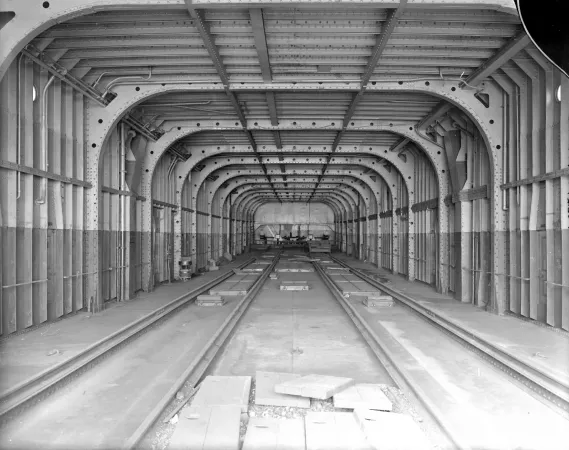Canada’s marine transportation artifacts will be better preserved in the Collections Conservation Centre
An important piece of Canada’s marine transportation history has set sail for a new home in the Ingenium Collections Conservation Centre.
The pilot house from the SS Prince Edward Island — a steam-powered railway ferry that changed how goods and passengers were transported to PEI — is part of the national science and technology collection. Curator Sharon Babaian explains that the artifact is significant because it represents a political and economic milestone in Maritime history.
“Marine transportation is incredibly important in Canadian history and even today,” says Babaian. “Our whole economy depends on marine transportation; even now, most of the products we want and need travel by ship and clear in and out of our ports — many Canadians don’t know that.”
The SS Prince Edward Island also has a direct connection to Canadian Confederation.
“The ship was basically the embodiment of the federal government’s promise to PEI — made in 1873 — that they would provide year-round transportation,” says Babaian. “That was part of the terms by which PEI came into Confederation.”
The SS Prince Edward Island was a powerful, state-of-the-art steamer with a train deck to transport rail cars.
“It took 12 cars; they would roll the cars onto the ferry and then the passengers would go upstairs,” says Babaian.
Like a well-appointed house
When first introduced, the ferry’s passenger quarters were considered to be quite impressive.
“The public room, with the officers’ and engineers’ accommodation, are on the upper promenade deck, entrance to which is obtained by four teak staircases from the promenade deck. The first class public rooms are handsomely fitted and the dining room is a large apartment at the forward end of the promenade deck. The floor is of oak parquet artistically arranged, and the framing and panelling throughout is of solid oak handsomely carved.”
~ Canadian Railway and Marine World, November 1914
Passengers dining aboard the ferry were provided with fine silverware. By all accounts, it seems it would have been quite a civilized way to travel.

A blue circle indicates the location of the pilot house on the SS Prince Edward Island.

This photo depicts the power of the SS Prince Edward Island to break through heavy ice.
A powerful, ice-breaking vessel
The SS Prince Edward Island also made waves because of its state-of-the-art ice breaking capabilities.
“It would go all winter long; it could get through four feet of ice,” says Babaian.
The vessel’s bow was heavily reinforced and its hull girdled by an extra belt of steel along the waterline. The main power source was two triple-expansion steam engines driving twin propellers. In addition, the vessel had a third engine driving a propeller forward. This served to improve ice navigation, by enhancing manoeuverability and generating turbulence in front of the vessel.
The ferry operated between Borden, PEI and Cape Tormentine, NB from 1917-1968, and significantly reduced the time and effort required to get goods to and from the Island. Before the SS Prince Edward Island, goods had to be transported by train to Cape Tormentine, unloaded and then moved onto a steamer for the trip across the Northumberland Strait to Summerside, Cape Traverse, Charlottetown, or Georgetown, and then reloaded onto a freight car on the PEI Railway.

The engine room telegraph, steering column, and wheel — with the binnacle in the background.
Using ship parts to tell stories
The pilot house, from which the ship is controlled, was located right at the bow. Its main components are the wheel, the binnacle (which contains the compass), and the telegraph (which transmits commands about the speed and direction from pilot house to engine room). Canadian National, the ship’s owners, later added the latest in navigational equipment — a Marconi radio direction finding set.
“We collected the pilot house as a way of talking about how ships operate, and preserving a really important vessel in Canadian history,” says Babaian, adding that very few museums in the world have the capacity to collect full-sized ships. “What we’ve always tried to do is collect things that represent marine transportation. We also have ship models, navigational equipment, anchors, ventilators, silverware, and portholes in the collection; we use these parts to tell stories.”
Weighing in at approximately 35,000 kg, the pilot house is among the first large artifacts that have moved from warehouse storage into the new Collections Conservation Centre, located next to the Canada Science and Technology Museum in Ottawa.
“Because it’s so large, it didn’t fit into the climate-controlled space we previously had for wooden objects,” says Babaian. “In the Collections Conservation Centre, it will be properly preserved.”












































































